The Australian Energy Market Operator has announced the impending departure of another two senior executives, including the architect of its invaluable Integrated System Plan, as a staff exodus continues.
The latest departures include Alex Wonhas, the head of engineering and system design who has led the work on the ISP, which is a 20-year blueprint on how to manage the shift to a renewables based grid.
The announcement of his departure comes just weeks before the anticipated release of the latest version of the ISP, which is expected to fast-track the timeline to a potentially de-carbonised grid from the early 1940s to the mid 2030s, in line with a 1.5°C scenario.
Another newly announced departure is Brett Hausler, a 22-year veteran of AEMO, who had been company secretary for nearly all that time, as well as other roles that included head of corporate affairs and general counsel.
CEO Daniel Westerman, who took up his position in May following the previous departure of Audrey Zibelman, said both Wonhas and Hausler had made substantial contributions to the energy industry, and left with the organisation’s best wishes.
However, the statement noted that AEMO is yet to find replacements, and both positions will be filled internally on an interim basis.
The departures of Wonhas and Hausler are the latest in a series of senior executive departures in recent months, including Mark Shilliday and Greg Elkins, the head and assistant head of national connections who left in late July, and Cameron Perrotte, the head of its WA operations, whose departure was announced in October.
Other recent departures include Jonathan Myrtle, the head of market insights; and Matt Armitage, the head of DER integration, who both left in October.
Joe Locandro, the former head of digital and business transformation, left in August, while the Hobart based Cameron Potter, the head of “sector coupling” left in October to join the green hydrogen team at Andrew Forrest’s Fortescue Future Industries.
The departure of Wonhas is the biggest surprise, given the upcoming release of the new ISP, which is expected to include details of the new “hydrogen superpower” scenario and bring forward the possible decarbonisation of Australia’s main grid to the mid 2030s, paving the way for more emission cuts elsewhere.
It is understood that Wonhas will still help deliver the draft version of the ISP in early December. Nicola Falcon, the head of forecasting, will act in the role after Wonhas leaves AEMO just before Christmas.
The ISP could also include a significant upgrade of what is considered by the industry to be the “most likely” scenario, which is important because the “most likely” scenario is used as the basis of the country’s transmission planning, regulatory rulings and investment and financing decisions.
Simon Corbell, the head of the Clean Energy Investment Group, underlined the importance of this in a recent episode of the Energy Insiders podcast.
Corbell said because the current “central scenario” had been considered “most likely” in the previous ISP meant that market bodies were using a scenario that assumes a 3°C to 4°C temperature rise, and this was impacting on key decisions on transmission and financing.
“At the moment, we’re using a market planning scenario, that is completely out of line with not only our commitments in relation to the Paris Agreement, but certainly well out of line with broader global investor sentiment.” he said.
In his statement, Westerman said Wonhas – previously the head of energy at CSIRO, and who had only two weeks ago had been given a new title of head of system design – had played a key role in implementing “major change” on behalf of AEMO, including the development of the ISP.
“Alex’s contribution is valued across the industry for the way he led AEMO’s collaboration on outcomes that benefit Australian homes and businesses,” Westerman said. RenewEconomy was told that both executives had left “on their own terms.”
The departure of a large number of senior executives has raised concern in some quarters about the loss of expertise, and morale in the organisation, but others are looking at it more positively, saying it shows that Westerman wants to stamp his own culture on the organisation.
Some noted that the market for executives in the energy industry at the moment was “hot”, particularly for those with AEMO experience.
“When executives leave, particularly as it follows the appointment of a new CEO, it demonstrates a cleaning of the deck,” said one former employee.
“These changes gives me hope, but expect more to come.” Indeed, RenewEconomy understands that at least one of the replacements for the recent departures has also flagged his intention to leave the position and return to his previous employer.
See also:
Energy Insiders Podcast: Australia will pay high price for Morrison’s lack of leadership
Energy Insiders Podcast: New AEMO boss Daniel Westerman
Energy Insiders Podcast: The clean energy transition, and how to connect it










